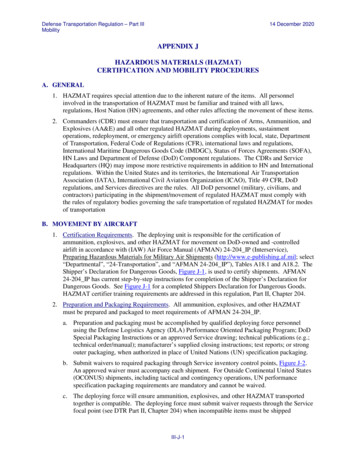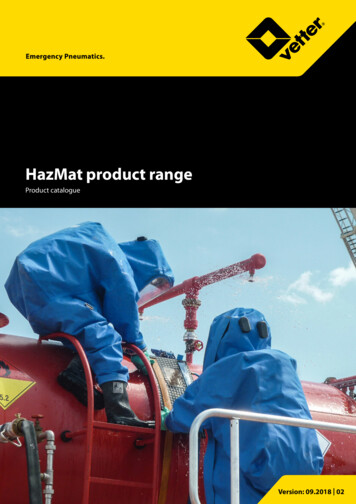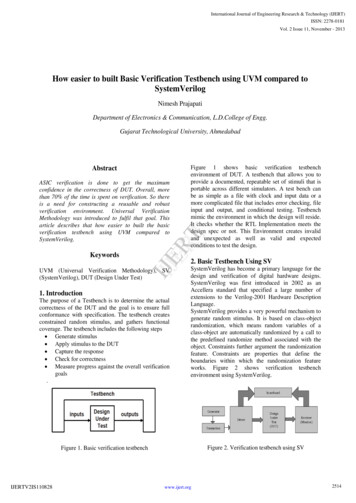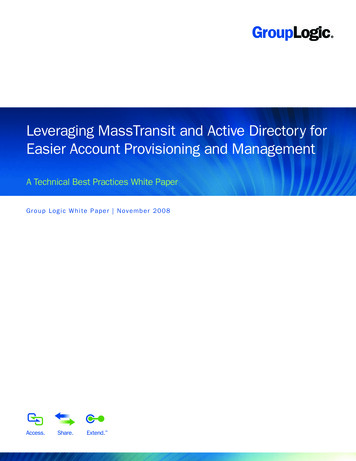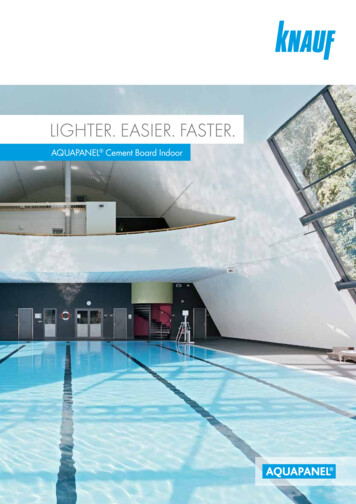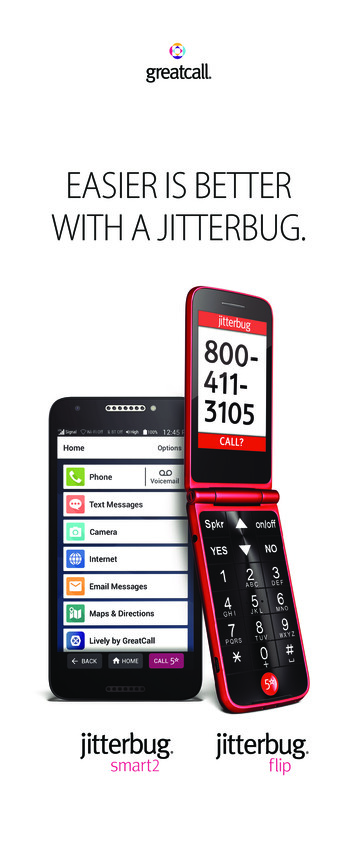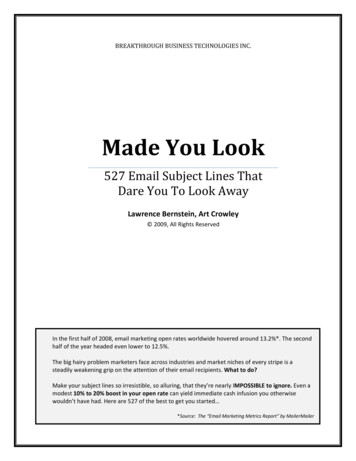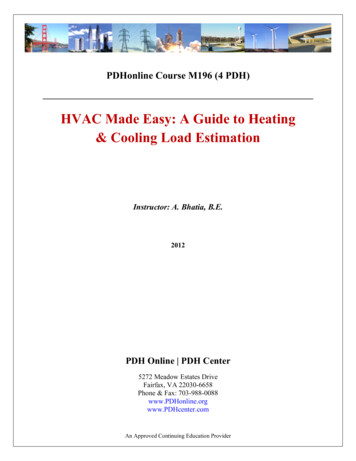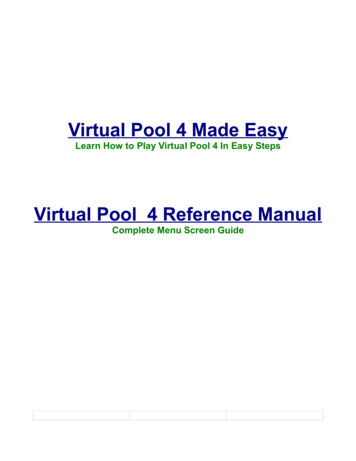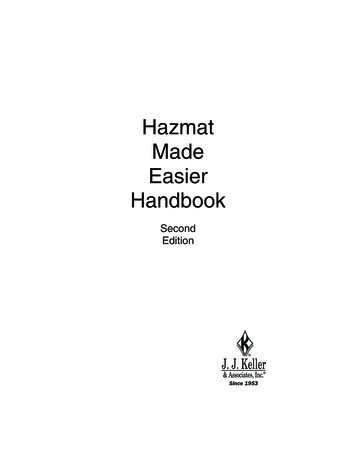
Transcription
HazmatMadeEasierHandbookSecondEdition
2008 J. J. Keller & Associates, Inc. Neenah, WI 54957 Printed in USAJ. J. Keller & Associates, Inc. 3003 W. Breezewood Lane, P.O. Box 368Neenah Wisconsin 54957-0368Phone: (800) 327-6868Fax: (800) 727-7516jjkeller.comLCCN: R123-317687ISBN: 978-1-60287-607-1GST No.: R123-317687Second Edition, Tenth Printing, August 2011All rights reserved. Neither the publication nor any partthereof may be reproduced in any manner without writtenpermission of the Publisher. United States laws andFederal regulations published as promulgated are in publicdomain. However, their compilation and arrangement alongwith other materials in this publication are subject to thecopyright notice.Due to the constantly changing nature of governmentregulations, it is impossible to guarantee absolute accuracyof the material contained herein. The Publisher and Editors,therefore, cannot assume any responsibility for omissions,errors, misprinting, or ambiguity contained within thispublication and shall not be held liable in any degree forany loss or injury caused by such omission, error,misprinting or ambiguity presented in this publication.This publication is designed to provide reasonably accurateand authoritative information in regard to the subject mattercovered. It is sold with the understanding that the Publisheris not engaged in rendering legal, accounting, or otherprofessional service. If legal advice or other expertassistance is required, the services of a competentprofessional person should be sought.The Editorial Staff is available to provide informationgenerally associated with this publication to a normal andreasonable extent, and at the option of and as a courtesy ofthe Publisher.Report Content Piracy800-388-7478www.siia.net/piracy
Hazmat Made EasierHandbookTable of ContentsLabeling. 35Placarding. 41
Labeling(Part 172, Subpart E)Hazard warning labels are meant tocommunicate immediate warning of ahazmat’shazards.The colors and symbols on the various labels are designed toprovide easy recognition of the hazard(s) ahazmat presents intransportation. Labeling requirements aretargeted almost exclusively at non-bulk packaging. The responsibility for the labelingprocess belongs to the person offering the hazmat for transportation. However, the carrier also is responsible. The carrier mustmake sure that packages containing hazmat have been properly labeled according to the requirements before accepting andtransporting them.Label specifications (172.407)Labels must be durable, weather resistant, and able to withstand, without deterioration or substantial change in color, a30-day exposure to transport conditions.Each diamond-shaped label must be at least 100 mm (3.9inches) on each side, with each side also having a solid lineinner border 5.0 to 6.3 mm (0.2 to 0.25 inch) from the edge ofthe label.The hazard class/division number must be at least 6.3 mm (0.25inch) and not greater than 12.7 mm (0.5 inch). If text indicatinga hazard is displayed, the text must be shown in letters measuring at least 7.6 mm (0.3 inch) in height. The words “Spontaneously” and “When Wet” must be at least 5.1 mm (0.2 inch)in height, respectively, for SPONTANEOUSLY COMBUSTIBLEor DANGEROUS WHEN WET labels.35
LabelingThe background color for the various labels must be as prescribed in 172.411 through 172.448, and the printing, inner border and symbol on each label must be as shown.In most cases, the symbol, test, numbers, and border must beblack. However, white may be used on a label with a one colorbackground of green, red, or blue. White must be used for thetext and class number for the CORROSIVE label.Primary and subsidiary labels (172.402)There are two types of hazard warning labels. A primary hazardlabel indicates a hazmat’s most hazardous property; a subsidiary hazard label indicates other less hazardous properties.Subsidiary labels have numbers in the lower corner, just likeprimary labels.You may see subsidiary labels that have no number in the lowercorner. Subsidiary labels without a number in the lower cornercould not be used in domestic transportation starting October 1,2005.When primary and subsidiary hazard labels are required together, they must be displayed next to each other (within 6inches).Determining labels (172.101 & 172.400)The Hazardous Materials Table is used for determining appropriate hazard warning labels.First, locate the proper shipping name in Column 2 of the Table.Then, refer to Column 6 for the appropriate label code(s).The first label code indicates the hazmat’s primary hazard. Anyadditional label codes listed are subsidiary hazards. Usually thelabel code is the same as the hazard class or division for thelabel. You can also use the Label Substitution Table in172.101(g). There is another table located in 172.400, thatshould be used in determining additional subsidiary labels.For the 6.1 label code, there are two possible labels. Hazmatthat has a Hazard Zone A or B requires a POISON INHALATIONHAZARD label; any other 6.1 hazmat will require a POISONlabel.36
LabelingExceptions (172.400a)As mentioned earlier, not all non-bulk packages of hazmat needto be labeled. Labels are not required on: A cylinder or Dewar flask (173.320) containing a Division2.1, 2.2, or 2.3 material; that is not overpacked; and that isdurably and legibly marked in accordance with CGA Pamphlet C-7, Appendix A. A package or unit of military explosives, including ammunition, shipped by or on behalf of the U.S. Department ofDefense (DOD) when in freight container-load, car-load, ortruck-load shipments, if loaded and unloaded by the shipper or DOD, or in unitized or palletized break-bulk shipments by cargo vessel under charter to DOD, if at least onerequired label is displayed on each unitized or palletizedload. A package of hazmat, other than ammunition, that isloaded and unloaded under the supervision of DOD personnel and is escorted by DOD personnel in a separatevehicle. A compressed gas cylinder that is permanently mounted inor on a transport vehicle. A freight container, aircraft unit load device, or portabletank that is placarded in accordance with or identified asprovided in the International Civil Aviation Organization(ICAO) Technical Instructions. An overpack or unit load device in or on which labels thatrepresent the hazard(s) inside are visible. A package of low specific-activity radioactive materialwhen being transported in a conveyance assigned for theexclusive use of the consignor under 173.427(a)(6). A package containing a PIH material in a closed transportvehicle or freight container may be excepted from labelingor placarding under certain conditions in 49 CFR 171.23. Not withstanding the provisions of 49 CFR 172.402(a), aDivision 6.1 subsidiary label is not required on a package37
Labelingcontaining a Class 8 (corrosive) material that has a subsidiary hazard of Division 6.1 (poisonous) if the toxicity ofthe material is based solely on the corrosive destruction oftissue rather than systemic poisoning. In addition, a Division 4.1 subsidiary hazard label is not required on a package bearing a Division 4.2 label.Certain exceptions for labeling requirements are also providedfor small quantities and limited quantities in 49 CFR Part 173.Label placement (172.406)A label must be printed or affixed to the outside surface of apackage containing hazmat, but not on the bottom. Labelsshould not be hidden or concealed; they must be easily seen.Labels must be on a background of contrasting color or have adotted or solid line outer border. You must also put the label onthe same side and near the proper shipping name, when possible.Duplicate labeling is not usually required on a package, only oneof each required label is necessary. However, duplicate labelingmay be required for larger packages and radioactive packages.See 172.406(e).What if the package is very small? A label may be printed on orput on a securely affixed tag or affixed by other suitable meansto: a package that is smaller than the required label if it is nota radioactive hazmat; a cylinder; and a package that has an irregular surface.Mixed and consolidated packaging (172.404)Hazmat with different hazard classes packed in the same packaging, or within the same outside container or overpack, mustbe labeled for each of the different hazard classes.Also, an outside container or overpack must be labeled as required for each class of hazmat when two or more packageswith compatible hazardous materials are put in the outside container or overpack.38
LabelingLabel modifications (172.405)Text indicating a hazard is not required on Class 1, 2, 3, 4, 5, 6,and 8 primary or subsidiary labels.The OXIDIZER label may be modified to display the word “OXYGEN” and the class number “2,” which can then be used insteadof the NON-FLAMMABLE GAS and OXIDIZER labels for packages with the proper shipping names “Oxygen, compressed” or“Oxygen, refrigerated liquid.” The word “OXYGEN” must appearon the label.The POISON label may be modified to display the text “PG III”below the midline of the label for packages containing a Division6.1, Packing Group III hazmat.639
LabelingORGANIC PEROXIDE label (172.427)HM-215I revised the ORGANIC PEROXIDE label. The newlabel reflects the fact that organic peroxides are highly flammable and enables transport workers to readily distinguish peroxides from oxidizers.Except for size and color, the ORGANIC PEROXIDE label mustbe as follows:The background on the label must be red in the top half andyellow in the lower half. White may also be used for the symbolfor the ORGANIC PEROXIDE label.40
Placarding(Part 172, Subpart F)Placards are often confused with labels, simply because they lookso much alike. Placards are much largerand are usually placedon much larger packages.The purpose of placards is very similar tothe purpose of labels.Placards communicatethe hazards associatedwith various materialsin transportation, andalso provide emergency personnel with the information they need when incidentsoccur — two good reasons why it is important to make sure youselect and display the right placards.Placarding requirements (172.504)Each bulk packaging, freight container, unit load device, transport vehicle, or rail car containing hazmat must be placarded,with some exceptions.To determine the placards required, you must know: Whether the packaging is bulk or non-bulk. The hazard category (class, division, packing group, ordescription), and subsidiary hazard(s), if any. The weight of non-bulk packages in each hazard category.41
PlacardingTable 1 (172.504)The most dangerous hazmat categories are located in Table 1.Any quantity of hazmat in the categories listed in Table 1 mustbe placarded.Table 1Placard nameCategory of material(Hazard class ordivision number andadditional description,as appropriate)Placard designsection reference (§)1.1EXPLOSIVES 1.1172.5221.2EXPLOSIVES 1.2172.5221.3EXPLOSIVES 1.3172.5222.3POISON GAS172.5404.3DANGEROUS WHENWET172.5485.2 (Organic peroxide, ORGANIC PEROXIDEType B, liquid or solid,temperature controlled).172.5526.1 (Material poisonous POISON INHALATIONby inhalation (seeHAZARD§171.8 of this subchapter))172.5557 (Radioactive YellowIII label only)RADIOACTIVE1172.5561RADIOACTIVE placard also required for exclusive use shipments of lowspecific activity material and surface contaminated objects transported in accordance with 173.427(b)(4) and (5) or (c) of this subchapter.Table 2 (172.504)The remaining hazard categories are in Table 2. Any quantity ofhazmat in Table 2 must also be placarded, with some exceptions allowed in the regulations.42
PlacardingTable 2Category of material(Hazard class ordivision number andadditional description,as appropriate)Placard namePlacard designsection reference (§)1.4EXPLOSIVES 1.4172.5231.5EXPLOSIVES 1.5172.5241.6EXPLOSIVES 1.6172.5252.1FLAMMABLE 542Combustible liquidCOMBUSTIBLE172.5444.1FLAMMABLE XIDIZER172.5505.2 (Other than organic ORGANIC PEROXIDEperoxide, Type B, liquidor solid, temperaturecontrolled)172.5526.1 (Other than material POISONpoisonous by inhalation)172.5546.2(None)8CORROSIVE172.5589CLASS 9 (see§172.504(f)(9))172.560ORM-D(None)43
PlacardingPlacarding exceptions (172.504) 1,001 lb rule(172.504)A transport vehicle or freight container that has less than 454 kg(1,001 lb) aggregate gross weight of hazmat in non-bulk packages, covered by Table 2, is not required to display placards.This exception does not apply to bulk packages or materialswith subsidiary hazards that must be placarded.DANGEROUS placard (172.504)A transport vehicle, rail car, freight container, or unit load devicecontaining non-bulk packagings of two or more categories ofTable 2 hazmat may display a DANGEROUS placard instead ofthe separate placards specified in Table 2.When 1,000 kg (2,205 lb) or more of one hazard category isloaded at one facility, on one vehicle, rail car, freight container,or unit load device, the DANGEROUS placard can not be usedinstead of the placard specified in Table 2.For example, when three or more different categories of Table2 hazmat are in one vehicle, rail car, freight container, or unitload device, and one material is over 1,000 kg (2,205 lb) and anindividual class placard from Table 2 is required, the DANGEROUS placard may still be displayed for other Table 2 categoriesfalling under the 1,000 kg (2,205 lb) limit.44
PlacardingResidue (172.504)A non-bulk packaging containing just the residue of a Table 2hazmat does not have to be included when determining placards for a transport vehicle, rail car, freight container, or unit loaddevice.Freight containers/unit load devices (172.512)A motor vehic
Handbook . Table of Contents . Labeling. 35 . Placarding. 41 . Labeling (Part 172, Subpart E) Hazard warning la-bels are meant to communicate immedi-ate warning of a hazmat’s hazards. The colors and sym-bols on the various la-bels are designed to provide easy recogni-tion of the hazard(s) a .
